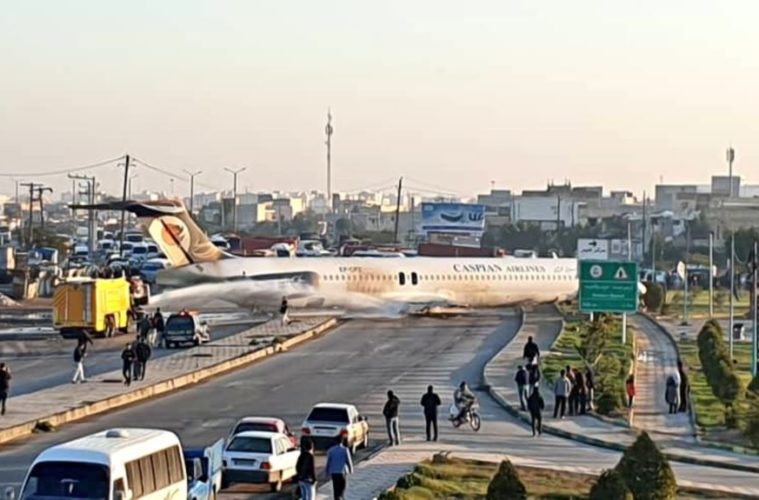February 07 2020

In one of the odder crashes in aviation history, an Iranian passenger jet has made a belly-flop landing at a provincial airport and skidded off the runway, beyond the airfield, finally coming to a halt across a major highway.
No one was killed and only two minor injuries were reported to passengers on the aircraft. When the plane came to a halt, crew aided the passengers in debarking and stepping down to the boulevard where the aircraft had stopped.
The Caspian Airlines plane was on a flight from Tehran to Mahshahr in Khuzestan province the morning of January 27 carrying 144 passengers and crew.
The plane was a US-made McDonnell-Douglas MD-83 manufactured in 1994 and delivered to a French airline. Caspian Air bought it in 2012.
Many Iranian news outlets insisted on calling the plane a Boeing, in an obvious effort to link the accident to Boeing’s problems with its newest jet. But Boeing only merged with McDonnell-Douglas in 1997, three years after the belly-flopping plane was built.
The cause of the belly-flop landing remains unexplained—as does the reason the plane skidded off the airfield and into the city. But one report said the plane landed with a tailwind rather than a headwind, despite the pilot’s request to land in the other direction. That meant the plane was being blown to some extent beyond the end of the runway.
As for the wheels-down landing, Iran has had a problem with a few of these in recent years.
One possibility is that the pilot forgot to put the wheels down. But that would be exceedingly unlikely as both the pilot and co-pilot check on the wheels before landing, so that would require both men erring.
Another possibility is that the crew could not get the wheels to descend and had no choice. This has happened previously to Iranian aircraft, suggesting poor maintenance. But if that were true, the ground staff of the airport should have deployed emergency equipment and sprayed the runway with fire retardant, something that was not reported.
A third possibility was that the wheels were lowered but did not fully engage and retracted when the plane hit the runway. That, again, would suggest a maintenance error and possibly a pilot error for landing too hard.
After such accidents in Iran it is the norm to blame the United States for refusing to sell spare parts to Iran for 40 years. But Iran has obviously been able to buy spare parts all those years or its planes would not have been able to fly for that time.
Furthermore, when Iran was allowed to buy Boeing parts in the 2016-17 period between the Obama and Trump sanctions, it only bought a solitary part, indicating it was able to get what it needed elsewhere.
Iran’s Civil Aviation Organization said the Mahshahr tower assigned a landing runway to the crew. The pilot asked to land in the opposite direction so he would not have a tailwind. The tower denied him permission. The FlightGlobal website said he would have faced a tailwind of about 6 miles per hour (10 KPH).
The state news agency quoted Mohammad-Reza Rezai, managing director of Khuzestan province airports as saying the pilot touched down further on the runway than he should have. The plane came to a halt about 100 meters beyond the ended of the runway’s paved area.
A state TV reporter traveling on the plane told the broadcaster the aircraft’s “back wheel had broken off, as we saw it was left on the runway.” The plane has one pair of wheels under the nose and three pairs of wheels under the wings and fuselage.
Iran’s last fatal air crash was just one year before the Caspian Airlines’ non-fatal mishap. In January 2019, a Boeing 707 military cargo plane carrying meat from Kyrgyzstan crashed while trying to land west of Tehran, killing 19 on board while one survived.
Caspian suffered its last fatal accident more than a decade ago in 2009 when an engine fire aboard a Russian-made Tupolev-154M erupted shortly after takeoff from Tehran on a flight to Armenia and the plane crashed in a flaming mass in a an open filed, killing all 168 aboard. No explanation for that crash has ever been issued.
But small mishaps have been the norm for Iranian airlines.
Five days after the Caspian jet when off the end of the runway, an Iran Air flight landing at Kermanshah in a snowfall slid about six meters off the end of the runway.
One day before the Caspian incident, a “malfunctioning engine” on a Qeshm Airlines flight leaving Gorgan forced the pilot to abort takeoff and evacuate all the passengers.
The day before that, an Iran Airtour Airbus A-300 that had left Tehran for Istanbul quickly circled back and landed after what the Civil Aviation Organization said was “a minor technical fault.”
That was four air flight incidents in the space of a mere eight days.
